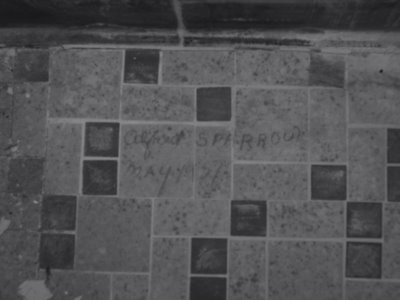Alfred Sparrow May 1957

This is my first picture for this photo blog experiment. There’s nothing much in the way of art to the photo itself (sorry!), but I think the subject it pretty neat. I found it underneath the bathroom cabinet in the in-law-suite of my project house. There it hid in the damp darkness since the house was built. We’re the first humans to set eyes upon it in nearly 50 years.
The last person to see it was named Alfred. Only his mother called him Alfred. To everyone else, he was Al or Sparrow. He’s probably dead now. I’m almost sure of that. At one time, he built homes for a living. He may have layed tile. Or, maybe he built cabinets. Regardless, we know he was a tradesman, who worked with his hands. He did good work - really good, honest work – the type of work that he’d be proud to attach his name to at the end of a long hard day. And on that Spring afternoon, his back sore from a day’s labor, his calloused hands taking aim with that knife-sharpened pencil, Alfred knelt down, the barely audible clang of his lunch pail against ceramic in the background.
He thought his name would live for eternity, because Alfred build the home to stand forever. That’s how they used to do it in those days. Homes were built with sticks and nails, sweat and mortar. It was all done on site, too. Today everything is pre-fab. Cabinets, roofs, even whole houses themselves are build in factories and wheeled onto site. Back in Alfred’s time, a heap of raw materials – yellow pine, Douglas fir, and cast iron - would skillfully be orchestrated into a home right there before your eyes. For the neighbors, it was a magician pulling a rabbit out of his hat.
But think about the name itself. Alfred Sparrow. What a burdened existence it must have been to live underneath a bathroom cabinet! Those 50 years would surely have seemed an eternal purgatory until salvation was delivered by my sledgehammer and wrecking bar, blue collared gods of thunder and lightening.
You could see the word “Alfred” recoiling from the light, his eyes having grown accustomed to the darkness, and, who, like a newborn, greeted this new place both with terror and awe. “Sparrow,” meanwhile, let out a big yawn and launched into a cat-like S T R E T C H that released him from the oppressive cursive by which he was bound for some half a century. As I depressed the lever on my photo-imaging machine, I wondered if “May 1957” could even recognize the strange world in which he found himself.

0 Comments:
Post a Comment
<< Home